The Maltese Falcon Auction
Home Page / Films Home / Anna's Favourites
2018 - Movie collectors to go Ga Ga for rare photograph famously featured in Queen's 1984 hit as it goes up for auction for £7,800
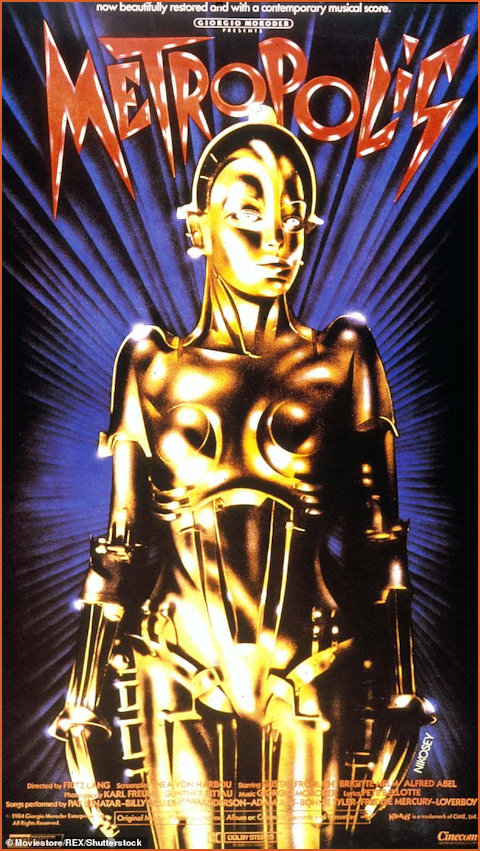
Metropolis was hailed by critic Roger Ebert as 'one of the great achievements of the silent era'. Picture shows a poster for the film
© Moviestore/REX/Shutterstock sourced via the Daily Mail
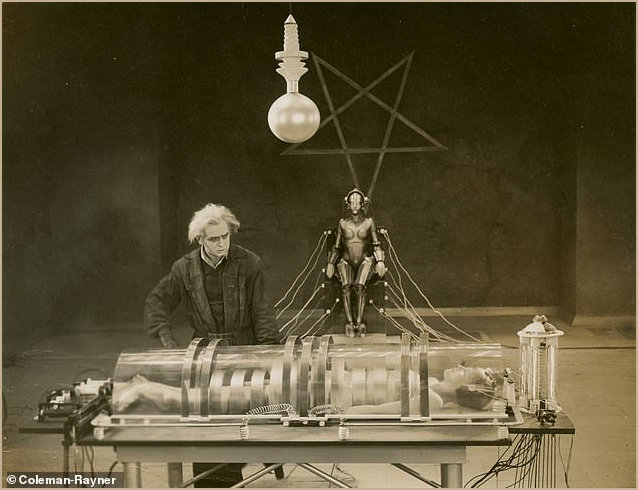
Image from science fiction film Metropolis is to be auctioned for £7,800. It shows scientist Rotwang downloading the 'essence' of Maria into a robot body - © Coleman-Rayner sourced via the Daily Mail
Image from science fiction film Metropolis is to be auctioned for £7,800
The photograph famously featured in Queen's 1984 Radio Ga Ga music video
It shows scientist Rotwang downloading the 'essence' of Maria into a robot body
By Daily Mail Reporter |Published: 10th December 2018 | Updated: 10th December 2018
Auctioneers expect movie collectors to go 'ga ga' for this rare photograph. The image is from ground-breaking science fiction film Metropolis, which is credited with starting the genre – and famously featured in Queen's 1984 Radio Ga Ga music video. The original double-weight semi-gloss photograph from Fritz Lang's 1927 classic is being auctioned in Los Angeles, and is expected to fetch £7,800 ($10,000). It shows scientist Rotwang, played by Rudolf Klein-Rogge, downloading the 'essence' of Maria, brought to life by Brigitte Helm, into a robot body.
The dystopian movie was hailed by critic Roger Ebert as 'one of the great achievements of the silent era'. Joe Maddalena, from auctioneers Profiles in History, said: 'This picture is an original German photograph release, which are super, super rare.' Bidding has opened and ends on Wednesday.
Read more : Earlier Metropolis Auction in 2012
2018 - The Maltese Falcon is a McGuffin!
The Maltese McGuffin
Daily Mail 5th January 2018
QUESTION The Maltese Falcon, a statue used in the Humphrey Bogart movie of the same name, has been described as a McGuffin plot device. What is this?
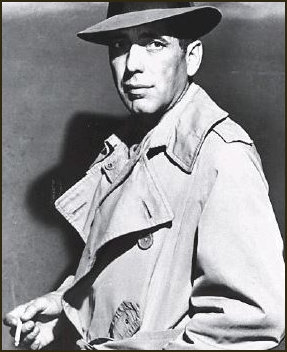
Image as it appeared in the Daily Mail article
A McGUFFIN, or MacGuffin, is a device for moving a movie’s plot forward, while, in itself, being relatively meaningless. In John Huston’s The Maltese Falcon (1941), the main characters struggle to gain possession of an apparently priceless objet d’art (pictured) without the audience being given much information about it. The statue is carried around in old newspaper, which scarcely seems appropriate for a valuable item. Possessing it is the sole aim of the characters, good and bad, and their struggles form the plot of the film. As to the origin of the term, we must thank the master of suspense, Alfred Hitchcock, who coined the term in a lecture at Columbia University in 1939.
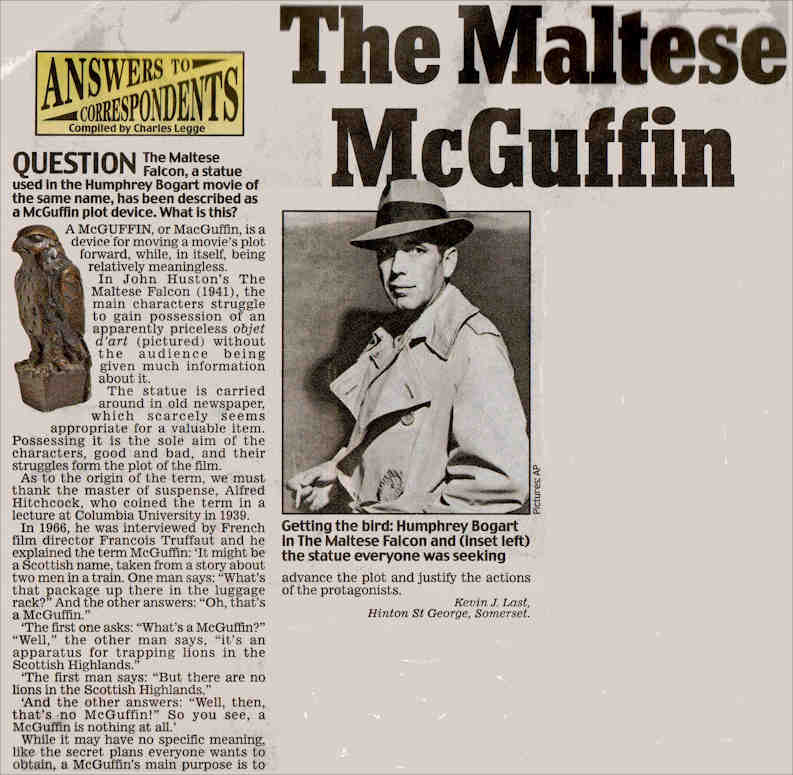
In 1966, he was interviewed by French film director Francois Truffaut and he explained the term McGuffin: ‘It might be a Scottish name, taken from a story about two men in a train. One man says: “What’s that package up there in the luggage rack?” And the other answers: “Oh, that’s a McGuffin.” ‘The first one asks: “What’s a McGuffin?” “Well,” the other man says, “it’s an apparatus for trapping lions in the Scottish Highlands.” ‘The first man says: “But there are no lions in the Scottish Highlands.” ‘And the other answers: “Well, then, that’s no McGuffin!” So you see, a McGuffin is nothing at all.’ While it may have no specific meaning, like the secret plans everyone wants to obtain, a McGuffin’s main purpose is to Getting the bird: Humphrey Bogart in The Maltese Falcon and (inset left) the statue everyone was seeking advance the plot and justify the actions of the protagonists. Kevin J. Last, Hinton St George, Somerset.
The most expensive prop in the world
I heard long ago that this prop, a particular favourite of mine, was due for the auction - it was obviously coveted by someone other than myself who had the money to spend.
Update 2016
Here is a reconstruction of the article and pictures (and what another set of pictures) as it appeared on the Vanity Fair web-site on 16th February 2016
The Mystery of the Maltese Falcon, One of the Most Valuable Movie Props in History
l to r Bogart, Peter Lorre, Mary Astor, and Sydney Greenstreet in a still from 'The Maltese Falcon'.
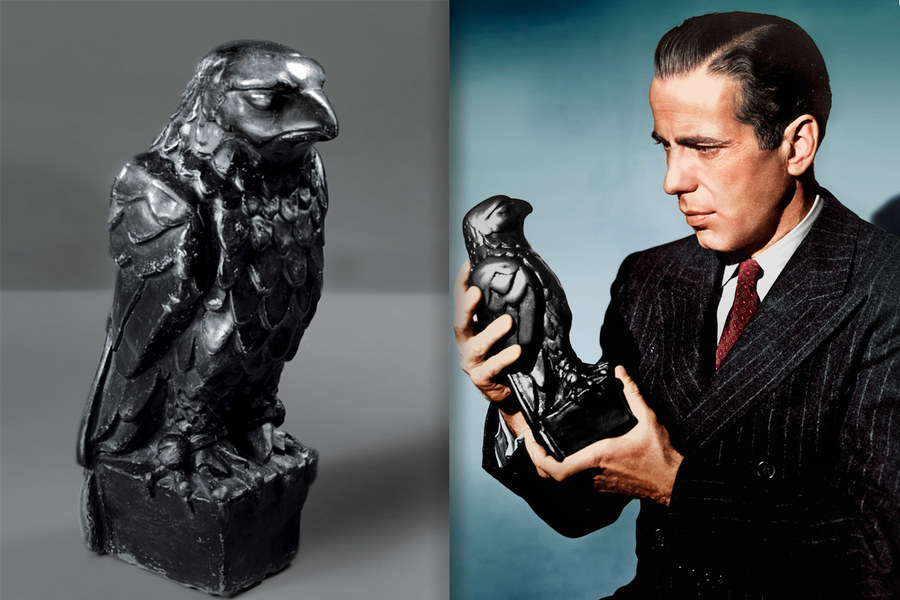
A BIRD IN HAND
Left, one of Hank Risan’s two plaster statuettes.; right, a still from The Maltese Falcon, with Humphrey Bogart admiring the elusive Falcon statuette.
Digital Colorization by Lorna Clark; Left, by Paul Schraub/The Collection of Hank Risan; Right, from the Everett Collection.
A statuette from the John Huston–Humphrey Bogart classic The Maltese Falcon is one of the most recognizable, and sought-after, pieces of movie memorabilia in history. In fact, Steve Wynn paid $4.1 million for it. But was it the genuine article? Bryan Burrough tracks down a flock of Falcons, with links to both Leonardo DiCaprio and a famous Hollywood unsolved murder.
by Bryan Burrough
“What is it?”
“The stuff that dreams are made of.”
“Huh.”
—A cop asking Sam Spade about the Maltese Falcon in the final scene of the 1941 film.
Along with the ruby slippers Judy Garland wore in The Wizard of Oz and Orson Welles’s “Rosebud” sled, which burns in the final frames of Citizen Kane, there is probably no more iconic item of Hollywood memorabilia than the Maltese Falcon, the black statuette that Humphrey Bogart, as detective Sam Spade, tracked down in John Huston’s classic film of the same name.
Lost to history for decades, it resurfaced in the 1980s in the hands of a Beverly Hills oral surgeon, and beginning in 1991 traveled the world as part of a Warner Bros. retrospective, with stops at the Centre Pompidou, in Paris, the Museum of Modern Art, in New York, and elsewhere. In 2013 it was offered for sale by Bonhams auction house. There was talk it might go for $1 million or more. But at the auction in Bonhams’s Madison Avenue showroom on November 25, 2013, the bidding quickly passed $1 million, then $2 million, then $3 million. Spectators gasped as a bidder in the audience dueled with one on the telephone, driving the price higher and higher.
Only when the bidding reached $3.5 million did the bidder in the crowd surrender, sending the Falcon to the man on the phone, who was later revealed to represent Steve Wynn, the Las Vegas hotel and casino billionaire. With the buyer’s premium, the total price came to a stunning $4.1 million. The crowd burst into applause. The auctioneers wheeled out a tub of champagne bottles to celebrate.
And with good reason. It was one of the highest prices ever paid for a piece of movie memorabilia, and two of the others were for cars: the original Batmobile, which had sold for $4.6 million earlier that year, and the Aston Martin Sean Connery drives in Goldfinger. News of the Falcon sale was carried on the network news and in newspapers around the world. Today it sits, along with a pair of Picassos, a Matisse, and a Giacometti sculpture, in a meeting room in Wynn’s Las Vegas villa.
That is the official version of what happened to the Maltese Falcon. But it is just one chapter in a complex tale. It turns out there is another, far stranger version, and another Falcon, several more in fact. And this version, which draws in characters as diverse as Leonardo DiCaprio and the woman butchered in one of Hollywood’s greatest unsolved murders, constitutes a real-life mystery every bit as bizarre as the one Sam Spade confronted on film.
Flight of Fancy
Hank Risan, the protagonist of this noir thriller, is as unlikely as the tale he has to tell. A sinewy, 60-year-old Internet entrepreneur, he works out of three modest office suites in downtown Santa Cruz, the Northern California surfing mecca. In Silicon Valley, Risan is best known for creating a massive library of computer-generated copies of popular songs, including the entire Beatles catalogue. When he took them online in 2009, selling individual downloads for a quarter, the EMI record label promptly sued to shut him down. (Risan settled without admission of liability for $950,000.)
His second business is a software start-up that Risan, using the shopworn promotional language of entrepreneurs everywhere, swears will “revolutionize” computer security. He says he is working with everyone from the Internal Revenue Service to the National Security Agency to put his software on government and corporate computers. In the start-up’s office, though, I see only a single employee working beneath whiteboards covered with calculations.
What one can say for certain is that, whatever the success of his business ventures, Risan is one of the country’s leading collectors of rare guitars. When he put nearly 300 of them up for auction two years ago, Guitar Aficionado termed it an “immaculate collection,” a “staggering” assemblage featuring instruments used by the likes of Eric Clapton, Mick Jagger, and Stephen Stills. Its centerpiece, still in Risan’s hands, is an 1835 Martin long owned by Mark Twain. In 1999 Risan played a Stephen Foster song on it on National Public Radio.
Dozens of guitars are on display at Risan’s home, a tidy urban compound packed to the rafters with modern art and collectibles, including a Warhol screenprint, and Risan’s latest obsession, antique British chess sets. We enter past a Jaguar in the carport, into a small room hung with graffiti-inspired paintings. “This is my Banksy room,” Risan says, taking a moment to explain the stories behind several of them.
Through the next door is a courtyard with a glassed-in guest house, a workshop where Risan’s assistant is busy restoring an antique guitar, a conversation pit, and a hot tub sitting under a set of bison horns.
We turn away from all this, stepping into the bungalow, then through a kitchen into a dining area.
“And in here,” Risan says with a flourish, “I might as well show it to you first. This is my Falcon.”
Suddenly here it is, plopped down in the middle of an antique chessboard like a massive rook, a foot-high black statuette of a falcon. The hunched, brooding shoulders are instantly recognizable.
There is a long moment of silence.
“This is the thing dreams are made of,” Risan announces.
I’m not sure what to say. He has told me he actually owns two Falcons. I ask where the other one is. “I leave it downstairs,” Risan replies. “It’s too fucking evil. It has the presence of surrealism. American surrealism. The evocation of evil that it manifests is not normally the kind of thing I like to collect. I like the Warhols, the chessboards. So I leave it in the basement.”
This is a lot to digest. Risan senses my skepticism.
“I know, right?” he says with a smile. “Weird. Weird guy with a lot of art.”
Flock Together
Over the last 25 years Risan has assembled an impressive team of allies, including a noted U.C.L.A. film professor and a former head of the United States Copyright Office, all of whom believe Risan’s Falcons are genuine. Risan puts the Falcon down on a tabletop in his courtyard and takes a seat beside it. “Ready?” he asks.
Risan describes himself as a mathematics prodigy who entered college at 16, eventually attending the University of California, Santa Cruz, Berkeley, and Cambridge University. In his late 20s, he says, he burned out and began a new life trading stocks and rare guitars. It was in 1985 or 1986 that he saw one of the Falcons for the first time, in the offices of a San Francisco illustrator who wanted to buy one of his guitars.
“I knew what it was immediately,” he remembers. “It was just sitting on a table.” The illustrator said he had two more identical Falcons, and they had all been used as props in the 1941 movie. They had been given to him by his son who, while working at Warner Bros. in the early 1980s, obtained them from a colleague who was in the property department. He thought they were genuine, but he had no way of knowing. Intrigued, Risan made two of the Falcons part of the guitar deal. (A few weeks later he got the third and then sold it.)
For years, knowing nothing else of their provenance, Risan kept one of the statuettes atop a television cabinet. Then, during the 1989 San Francisco earthquake, it toppled to the floor. It wasn’t damaged, but Risan says he realized it should be insured. To obtain insurance, however, he needed to have it authenticated.
Risan contacted Christie’s auction house about his Falcons. In response he was told that they were probably not made for the 1941 John Huston film but for another movie altogether: the 1975 Maltese Falcon satire, called The Black Bird, starring George Segal. Apparently, dozens of plaster replicas had been made for that movie.
Looking for an expert to sort this all out, Risan called the film department at U.C. Santa Cruz and was passed to Vivian Sobchack, the dean of the arts division. (She is now professor emerita at the U.C.L.A. School of Theater, Film and Television.) In the summer of 1991, Risan took one of his Falcons, wrapped in a bath towel, to Sobchack’s home and handed her a manila envelope full of old Warner Bros. publicity stills. “I just figured he was some sort of leftover Santa Cruz hippie,” Sobchack recalls. “He constantly was telling these stories that were extravagant.”
Sobchack called a colleague and together they spent a day examining the statuette. This was before the Internet, so they watched The Maltese Falcon on a VHS tape. Freezing frames of the movie and comparing Risan’s statuette to the publicity photos, Sobchack began to feel the statuette was genuine. Both the bird in the film and the one in her hands had a strange, irregular base.
Mysteriously, there was an identical marking near the base on each of Risan’s Falcons. It appeared to be two numbers: a 7 with a crossbar and a 5, each followed by a period. Could it be a “7.5.,” referring to the 1975 film? Sobchack hadn’t a clue. Neither did Risan.
Risan recalls that Sobchack said, “I think it’s real, but we’ve got to do a lot more work to make sure.” She suggested they start at Warner Bros. itself. Risan managed to make an appointment with Edward Baer, an assistant manager in the property department, who had been at the studio for 37 years.
A kindly sort, Baer told Risan and a Santa Cruz art-history professor who had come along that he had personally designed the statues made for the 1975 film; later, when they showed him one of Risan’s Falcons, Baer said it was nothing like those he had designed. Baer explained that he had made the 1975 Falcons from the original 1941 mold, which he had fished out of a Warner Bros. warehouse. But the mold had deteriorated, so after using it to make a single replica out of resin, he destroyed the mold, then used the resin Falcon to make a new mold. The replicas made from this mold were scrunched forward and a little lopsided—sad cousins of the original.
Baer told Risan about another Falcon he knew of, this one in the hands of the Beverly Hills oral surgeon, Gary Milan. It was nothing like Risan’s. It was made of lead and weighed 45 pounds. Risan’s plaster Falcons weighed barely six pounds. Milan fervently believed the heavy lead Falcon was the one used in the 1941 film.
But it wasn’t, Baer insisted, and he knew why: according to Risan, Baer, who has since died, said he had made Milan’s lead Falcon himself, for use in the 1975 film. Someone, Baer volunteered, had later removed the lead Falcon from the prop warehouse and sent it to an outside metal-maker who “distressed” it to make it look old. This was the lead bird, Baer claimed, that had privately been sold to Gary Milan.
The meeting with Baer had been going on for almost an hour when, Risan says, another Warner employee stuck his head into Baer’s office and said, “What’s going on?” From his demeanor, the man clearly didn’t like what was being discussed. There was a quick, awkward exchange, during which Baer adjourned the interview. As Risan left, Baer slid him a business card with his home number scribbled on the back. “Call me,” he said.
They spoke the next day. The man who broke up their meeting, Baer said, was his colleague—the same man, Baer claimed, who had quietly sold the lead Falcon to Gary Milan for around $70,000 in the mid-1980s. At the subsequent meeting, when Risan showed Baer his own, plaster Falcon, Baer said, “This is the right one,” and pointed out an array of characteristics, including the base.
Two days later, Risan says, Baer called to say he had just been fired without cause. As Risan puts it, “That’s when this whole thing began to feel like a detective story.”
Waiting in the Wings
Back in Santa Cruz, Vivian Sobchack couldn’t believe anyone would actually think a heavy lead Falcon had been used in the movie. Studio props, she knew from her own research, were typically made of cheap plaster. There was no way, she felt, that the studio would ask Humphrey Bogart to lug around a 45-pound monstrosity when a 6-pound plaster Falcon would suffice. Viewing the film, she believed the Falcon wobbled, in a way that a heavy object wouldn’t.
Meanwhile, Risan visited the Warner archives at U.S.C. An archivist brought out a folder bearing maybe 10 sepia-toned pages about the Falcon. One studio memo said John Huston himself had been involved in commissioning the statuette for the film. He had contracted an artist to make it for $75.
Over the next few months Risan and his professor friends made several more trips to Los Angeles. On one, they called the Warner Bros. retirement club and got the names of two people still alive who had worked at the studio in 1941. The first was a man named Ben Goldmond, who had worked in the Warner prop room from 1929 to 1974.
Risan telephoned him. When Risan described his Falcon, he says, Goldmond asked, “Does it have a serial number?”
“No,” Risan said.
“Then I’ll take the meeting.”
Serial numbers, Goldmond explained when the two met at a delicatessen, had been introduced at Warner during the 1960s. If Risan’s Falcons didn’t have them, it bolstered the case they had been made earlier. Goldmond hadn’t worked on the Huston movie, but he remembered seeing three black plaster Falcons in the prop room. When Risan showed him his, he said it might be one of them. He couldn’t be sure.
But the second contact was. Her name was Meta Wilde. She had been William Faulkner’s mistress for 18 years, an affair she chronicled in a best-selling 1976 book, A Loving Gentleman. During a long Hollywood career, Wilde had served as script supervisor on more than 200 films, including The Maltese Falcon. An elegant woman then in her 80s, Wilde welcomed Risan, his girlfriend, and a Santa Cruz professor into her Beverly Hills condominium in September 1991.
As John Huston’s script supervisor on The Maltese Falcon, Wilde was responsible for props “continuity”—that is, making sure everything looked exactly the same in each shot, especially if actors and props had been moved. That made her the de facto keeper of the Falcon. She recalled that they had used four Falcons during the filming, three of plaster and one of metal—but not heavy lead.
Was a heavy lead bird ever used on the set? Risan asked at one point.
“Absolutely not,” Wilde replied, according to Risan. “I could never carry that around. Neither could Humphrey Bogart.”
When Risan showed her one of his Falcons, she said, “This is exactly like the ones I was involved with when making the picture. It seems to me that this is actually the bird we used. This is one of the plaster birds.” At one point, she ran her hand lovingly over Risan’s Falcon and murmured, “It’s good to touch you again, old boy.”
Wilde was so convinced, she agreed to write a letter stating that Risan’s Falcons were the ones used in the film. With it, and with the testimony of Ben Goldmond and Edward Baer, Risan was able to get his two Falcons insured. It was at that point that he informed Gary Milan, the oral surgeon who owned the “official” Falcon, of his findings.
When I spoke to Milan in December, he made it clear in no uncertain terms that he finds Risan and his birds to be fraudulent. “It’s a very shabby subject, in terms of people out there who have plastic birds and plaster ones,” he said, quickly growing agitated. “You’re getting onto a very slippery slope. He [Risan] got involved with Warner Bros. and all the Warner Bros. lawyers, and they shot him down and shot him down badly. If he is resurrected, you may find yourself in the middle of a very nasty lawsuit with Warner Bros.” (Risan denies ever having any communication with Warner Bros. lawyers.)
Milan is cagey about how he came to own his lead Falcon, saying only that it “came” to him after he earned some publicity for selling one of the pianos played in Casablanca. He did manage to obtain a letter from a Warner Bros. archivist authenticating the bird, and saying it was used in the 1941 film.
Milan had lent it to Warner, in fact, which displayed it in a company museum for years. The case for the Milan Falcon rests on documents found in the Warner Bros. archives. One says the Maltese Falcon was made of lead and weighed 47 pounds, just about the same as Milan’s; however, the memo may be talking about the fictional Falcon—the one described by Dashiell Hammett in the novel upon which the movie is based, not necessarily the prop being carried around on the movie set. A Warner Bros. press release mentions an accident during filming when the Falcon was dropped on Humphrey Bogart’s foot, bruising two of his toenails. The incident apparently bent one of the Falcon’s tail feathers. That damage, Milan says, can be clearly seen on the Falcon he sold to Steve Wynn.
Milan insists there is no evidence any plaster Falcons were made for use in the 1941 film. He makes the same charge about Risan’s Falcons that Risan makes about his: they were made for the 1975 movie. “The Hank Risans out there will never stop,” Milan harrumphs. “But any four-year-old can see the one in the film matches mine, and the others do not.”
Risan fires right back, saying of the Milan Falcon, “It’s one of the worst fakes I’ve ever seen. A seven-year-old could see this is a fake. Just look at the photos.”
In fact the visual evidence in the movie seems to support Milan’s case in that the Falcon’s recessed breast feathers seen in close-up match his Falcon’s, not those of Risan’s, which are raised and quite different. (Risan argues that this is due to lighting and 1940s photographic techniques.) On the other hand, the actors seem to be holding and moving an object far lighter than 47 pounds.
Risan didn’t care what Gary Milan thought, and he had no intention of going public or initiating any dispute. He wasn’t interested in displaying or selling his Falcons; he just wanted them insured. “It was Q.E.D.,” he says today. “This was over for me.”
The Birds and the Fees
The plot, in fact, was only beginning to thicken. Because just as Risan and his two Maltese Falcons stepped off the stage, another Falcon stepped on—actually two. The first surfaced that same year, 1991, at the Golden Nugget flea market, in Lambertville, New Jersey, where it was spotted by a documentary-film maker named Ara Chekmayan. Chekmayan had earned an Oscar nomination for his 1983 film, Children of Darkness, and was a three-time Emmy winner. He found the little statue—a foot-tall black Falcon made of resin—among several rusted tools. On the bottom of it he found a serial number, 90456 WB. He immediately suspected that the Falcon might have been used in the 1941 film, and he bought it for $8. Much like Risan had done, Chekmayan launched his own quest to authenticate his Falcon. His brother interviewed Meta Wilde; she thought it could be another of the three or four 1941 Falcons. Confident he had a genuine item, Chekmayan put it up for auction at Christie’s East. But Christie’s pulled the item weeks before the auction after Warner threatened to sue if Christie’s claimed the Falcon was tied in any way to the movie.
In fact, there were indications the studio wasn’t entirely sure of the provenance of either the Milan or Chekmayan birds. In a 1997 New York Times article about Chekmayan’s Falcon, the newspaper quoted a Warner executive, who preferred to remain anonymous, saying there was no way to tell which, if either, of the two Falcons had been used in the movie. Prop records had long since been lost. “Basically,” the executive told the Times, “it goes on faith.”
Chekmayan gave in. Risan, for one, believes the Chekmayan bird was made for the 1975 movie. It is made of cold-cured polyester resin, he says, which was invented only in 1946 and, along with the serial number, seems to conform to Baer’s description of the one he made for the later film. Even so, Chekmayan’s story eventually had a happy ending. He did manage to have his Falcon authenticated by a reputable Los Angeles gallery; in 2000, it was sold at auction for $92,000 to an unidentified bidder. Ten years later it was sold again, this time for more than $300,000, to a group that included Leonardo DiCaprio.
The second new Falcon appeared in 1994, and this one’s authenticity couldn’t be dismissed. A heavy lead statuette with a bronze patina, it was found in the California home of the actor William Conrad, star of the Cannon television series, after his death. Warner Bros. confirmed that it had been given to the actor as a gift by studio chief Jack Warner during the 1960s and it had sat for years on a shelf in Conrad’s den. In fact, legend around the Warner lot has it that Jack Warner kept the 1941 Falcon mold and from time to time would have a lead Falcon cast from it as a special gift (although no others of this kind have yet surfaced). Weighing 45 pounds and made of lead, the “Conrad Falcon” closely resembled the Milan Falcon, including the recessed breast feathers. In addition, it had what appeared to be slash marks, which may have been made during the movie’s filming in a scene in which the statuette is attacked with a pocket knife.
Reversing its earlier position, Warner now confirmed that there was not just one Falcon but at least two.
The Conrad Falcon had a notable fate. Christie’s put it up for auction in December 1994, and it sold to the New York jeweler Ronald Winston, son of the famed Harry Winston, for $398,500, then a record price for a movie prop. The Falcon so captured Winston’s imagination that he wrote a short play about what might have happened to the fictional Falcon after the story told in the 1941 film. He hired a well-known Bogart look-alike, Tony Heller, to play Sam Spade and staged the play as a private event for a select group of invited guests.
Afterward, Winston used the Conrad Falcon as the model for a new Falcon made of 10 pounds of gold. Its eyes were two Burma-ruby cabochons. From its beak Winston hung a 42-carat diamond. All told, the Winston Falcon took two years and $8 million to make. It was displayed at the Academy Awards in 1997.
After creating his bejeweled gold replica, Winston sold the Conrad Falcon to an unidentified buyer, for a price he claimed was far above what he had paid. Where that Falcon resides today is anyone’s guess.
On a Wing and a Prayer
For 20 years after insuring his two Falcons, Hank Risan paid them only intermittent attention. In 1999 a friend at Christie’s urged him to sell them at auction. Risan agreed to a meeting or two but dropped the matter when he heard Gary Milan was threatening to sue. “I said, ‘The hell with it,’ ” he says. “ ‘It’s not worth the trouble.’ ”
But the trouble never went away. In 2005, Risan and his Falcons were featured in an online article, the first public mention of their existence. The article quoted a 1991 letter from Vivian Sobchack to the effect she believed they were genuine. Several days later, Sobchack says, Milan called the chancellor of U.C.L.A., claiming she was involved in an unethical appraisal business. Nothing came of it.
The mystery of Risan’s Falcons began to clear up only in 2012, when he decided to sell off a quarter of his guitars and his Falcons. To have a chance of doing so, he needed to update their authentication. It had been more than 20 years, after all, since he had done his initial research. He asked his public-relations consultant, Mark Marinovich, to help out.
Marinovich began Googling, something Risan hadn’t been able to do in 1991 and hadn’t been interested in doing since. What he discovered stunned everyone who had ever been involved in Risan’s inquiry. It was a book, a best-seller in fact: Black Dahlia Avenger, published in 2003, written by Steve Hodel, a retired police detective. The Black Dahlia was a nickname the Los Angeles press had given to a gruesomely murdered woman named Elizabeth Short, whose mutilated body, cut in half at the waist, was found in the city’s Leimert Park neighborhood in January 1947. Hodel had uncovered evidence suggesting that his late father, a doctor named George Hodel, killed Short. To this day, the Black Dahlia case remains one of L.A.’s most notorious unsolved murders. Many believe Steve Hodel is right. Others are skeptical.
To Risan and his circle, two assertions burst from the pages of Hodel’s book. During the 1940s, Dr. Hodel had run in a circle of celebrated artists and filmmakers that included director John Huston and the noted Surrealist Man Ray. According to the book, one of Hodel’s closest friends was Fred Sexton, an artist who was also a friend of Huston’s. In a single aside, the book made the claim that Huston had Sexton sculpt the original Maltese Falcon.
It was the first time Risan had seen any artist’s name associated with the Falcon’s creation. But that wasn’t the only thing the book had to say about Fred Sexton. It was Steve Hodel’s theory not only that his father had killed Elizabeth Short but that his accomplice in a series of other unsolved murders during the 1940s had been none other than Fred Sexton.
Risan began searching for information about Sexton. There wasn’t much. He was born in 1907, and from the age of 22, when a Los Angeles Times critic saw one of his paintings and began championing him, he was a prominent if not exactly famous local artist. Though seldom able to make a living from his art—he drove a taxi during the 1930s and 40s—Sexton displayed his work in Los Angeles galleries for 20 years, until moving to Mexico in the 1950s. He died there in 1995.
Risan was skeptical about Hodel’s murder theory—the evidence seemed circumstantial to him—but he didn’t really care whether Sexton was a murderer or not. All he wanted to know was whether Sexton had made the original Maltese Falcons, and whether that knowledge could somehow help authenticate his birds. He searched the Internet in vain for images of paintings or sculptures Sexton had made. What he found instead were paintings by a different Frederick Sexton, a Connecticut landscape artist who died in 1975. A Southern California gallery had a Frederick Sexton still life for sale. On a hunch that it may have been misattributed to the Connecticut Fred Sexton, as in fact it turned out to have been, Risan bought it and had it shipped to Santa Cruz.
When it arrived, Risan tore off the wrapping and studied the painting. That’s when he saw it: The signature. It was “F. Sexton.” He recognized the writing immediately, especially the first letters, the F and the S. On the painting they were block letters with a crossbar through the reverse F—an exact match for the unexplained markings near the base of his Falcons. The strange “numbers,” he realized, weren’t a “7.5.” They were the block letters “F.S.”
The Feathers Fly
A whole new aspect of the story came tumbling out once they tracked down Sexton’s daughter, Michele Fortier. In August 2013, Risan brought Vivian Sobchack and a film crew to Fortier’s home in Los Angeles. Inside, they found dozens of Fred Sexton’s paintings and sculptures, which Fortier had gathered from friends and family for the interview.
Her father and John Huston, Fortier said, had been friends since high school. As a nine-year-old in 1941, she had seen her father’s sketch designs for the Falcon on a manila envelope. In the ensuing weeks she saw his sculpted clay model, which was later cast in plaster for the movie. She knew nothing about a lead Falcon; her father never worked with lead. Fortier remembered being on the set when Bogart delivered the Falcon to actor Sydney Greenstreet, playing Kasper Gutman; she recalled Bogart telling her to be quiet, then saying “Boo” as a little joke. She identified the “F.S.” on one of Risan’s Falcons as her father’s signature, then signed a letter of authenticity making it official.
More research filled in some of the blanks. In all, there appear to have been at least six plaster Falcons created for the 1941 movie, an assertion first made in a little-noticed 1983 memoir by a onetime Warner employee named Stuart Jerome. One is thought to have been damaged, then destroyed, during filming in 1941. By this count, Risan owns Falcons two and three; he sold four, to a buyer who declines to be identified. According to an article in a U.S. Copyright Office newsletter, Warner Bros. gave a fifth Falcon to the Copyright Office for an exhibition in 1984. The article says one more plaster Falcon, the sixth by this count, was still in the Warner warehouse at the time. During the course of research for this article, I spoke to a credible individual who said he had recently seen this Falcon—of unpainted plaster—in the warehouse.
Not that this evidence convinced potential buyers. In 2013, both Risan and Gary Milan put their Falcons up for sale. At the Guernsey’s auction house in New York, Risan set a minimum price of $1.8 million. No one bid that high. Instead, just three weeks later, Bonhams sold Milan’s lead Falcon for $4 million.
What happened? Risan sighs. “Guernsey’s did a shitty job,” he says with a shrug. “Bonhams had a big marketing department. We didn’t. They didn’t market it properly. There was very little interest in our sale. Everyone was interested in the Bonhams auction.” (A Guernsey’s executive declined to respond to a request for comment.)
The fact is the auction of Risan’s Falcon seemed to come out of nowhere. Its back story was too complex, too new, for buyers to easily digest. The Milan Falcon had been recognized as the “official” Falcon for 20 years, and had the studio’s backing. What made things worse was that Guernsey’s decided to make its case for authenticity in part by attacking the authenticity of Milan’s. “They really shit the bed on that one,” says Laura Woolley, a leading appraiser of Hollywood memorabilia. “You just don’t do that. They pissed everybody off, and now no one really wants to hear anything more about it.”
When Risan’s Falcon failed to sell, Gary Milan’s lead Falcon was left to rule the roost.
Bird’s-Eye View
Near the end of my research, I called Warner Bros. A studio spokesman won’t say anything on the record, but there are some at the studio who will talk privately. According to these people, old-timers at the studio remain 99 percent certain the Milan Falcon was used in the 1941 film. The bent tail feather, they say, proves it.
When I showed these same people the results of Risan’s investigation, they acknowledged his case is compelling, and agree that plaster birds were also made for the film. The plaster Falcons, they say, may have appeared in the movie when the lead ones were deemed too heavy; perhaps the latter were used mostly for close-ups and publicity photos. Seventy-five years later, it’s hard to know. “It’s impossible to prove or disprove any of these theories at this point,” I was told. “We just don’t know. But it is a great mystery story.”
Maybe the keenest neutral observer of all this is Laura Woolley, the Hollywood appraiser. A professional skeptic, she has issues with both the Risan and the Milan Falcons. “I don’t understand why anyone would make a lead bird,” she says. “You don’t cast in lead. But Warner’s believes in it. Gary believes in it. So it’s kind of become the official bird.” She goes on. “[Lead] only makes sense if you wanted something that appears very heavy. If it’s supposedly something that contains treasure inside, you should be holding it as something quite weighty, and that’s the only reason you could ever do it in lead. Maybe they dropped it on Bogart’s toe and went to plaster instead. Who knows?”
Woolley is persuaded that plaster Falcons were made for the 1941 film, but she says there is no way to know whether Risan’s were among them. “Once you have a mold, you can crank those things out all you want,” she says. “So, you tell me which one was used on the screen. There’s no way to know. I’ve heard people in both camps make good arguments. I think it’s one of those things that may never be known.”
It’s a shame to end this story on an ambiguous note, but it’s much the same ending that Hammett wrote for his novel and John Huston shot for his movie. Sam Spade remained in foggy San Francisco, Kasper Gutman headed to Istanbul, and the mystery of the Maltese Falcon lived on, unsolved.
Here is a reconstruction of the original article and pictures (and what a set of pictures) as it appeared on the Daily Mail Web-site:
Lead bird statue from Bogart's classic film 'The Maltese Falcon' sells at auction for more than $4MILLION
By Helen Pow PUBLISHED: 05:56, 26 November 2013 | UPDATED: 09:57, 26 November 2013
A lead statue of a bird from in the classic 1941 detective thriller 'The Maltese Falcon' featuring
Humphrey Bogart has sold for more than $4 million.
An unidentified buyer paid a hefty $4,085,000 for the 45-pound, 12-inch-tall prop, according to Bonhams auction house, which sold the item.
The black figurine of a falcon on a pedestal with smooth breast feathers, almond eyes, and rounded tail feathers is one of two known cast lead statuettes made for the film.
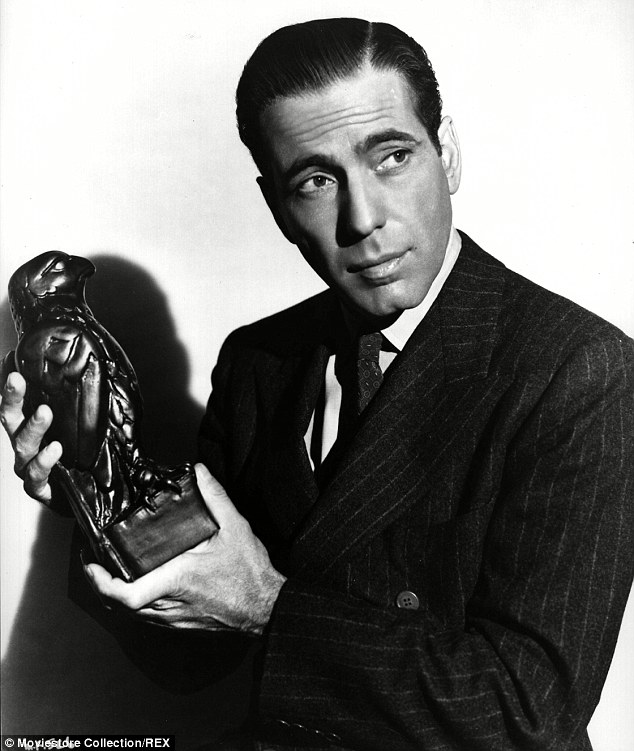
Sold: The lead statue of a bird, pictured, from in the classic 1941 detective thriller 'The Maltese Falcon' featuring Humphrey Bogart has sold for more than $4 million
However, Warner Bros. archives confirm it was the only statue to actually appear in John Huston's directorial debut, Bonhams said.
The auction house declined to provide a pre-sale estimate for the item, which was offered up along with other classic movie memorabilia.
The winning bid came over the phone.
The bird has a Warner Bros. inventory number 'WB 90067' etched to rear tail feathers and underside of the bird and also bears the name of the movie.
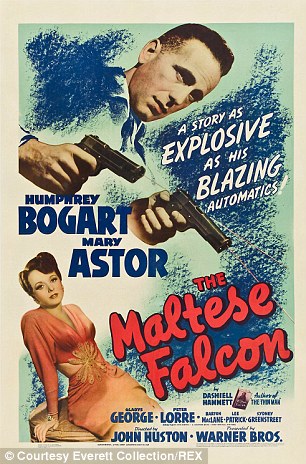
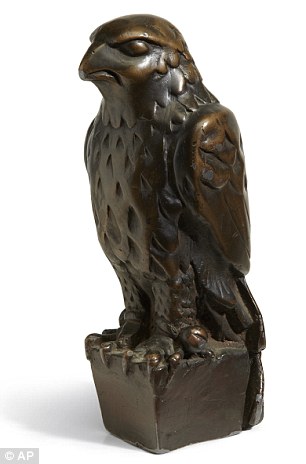
Only one: Warner Bros. archives confirm the statue, right, was the only one to actually appear in John Huston's directorial debut, left - images courtesy & © Everett Collection and PA
Humphrey Bogart plays San Francisco detective Sam Spade in the film. Spade tangles with three nefarious characters played by Mary Astor, Sidney Greenstreet, and Peter Lorre, all of whom are chasing a statuette they believe to be a gold and jewel-encrusted figure of a falcon, but which ultimately is revealed to be made of lead.
The figurine has some damage, a bent right tail feather and some scratches to the head and chest, though that may have heightened rather than hindered its sale price because it was incurred during filming.
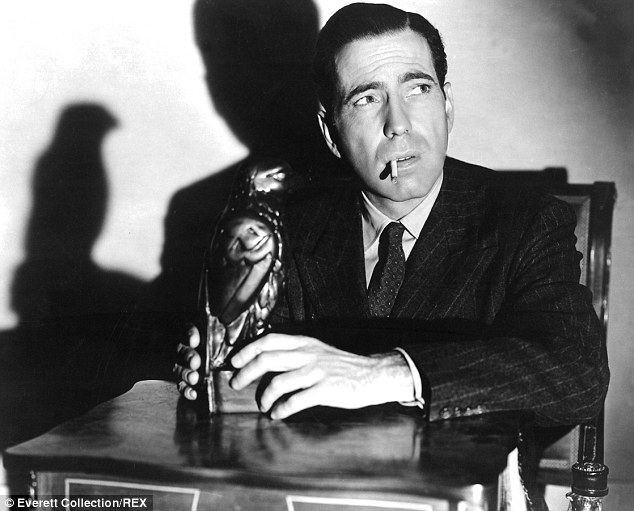
Famous: Humphrey Bogart, pictured, plays San Francisco detective Sam Spade in the film
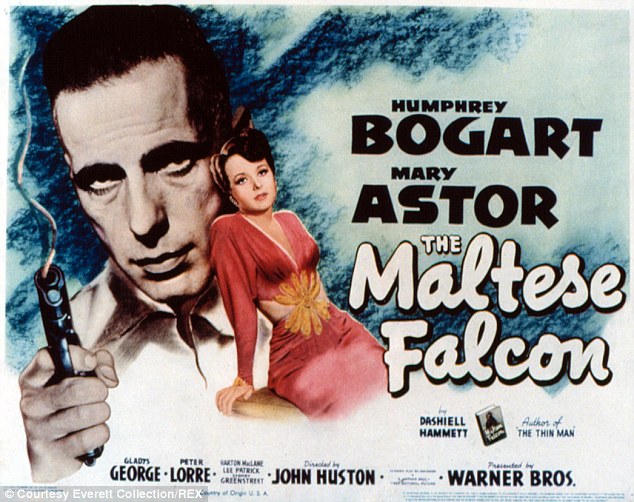
Plot: Spade tangles with three nefarious characters played by Mary Astor, Sidney Greenstreet, and Peter Lorre, all of whom are chasing a statuette they believe to be a gold and jewel-encrusted figure of a falcon, but which ultimately is revealed to be made of lead
According to Bonhams, actress Lee Patrick, who played Spade's secretary, Effie, dropped it while handing it to Bogart.
The statue's unidentified owner bought it privately in the 1980s.
It has been exhibited at the Warner Bros. Studio Museum, the Pompidou Centre in Paris and the Museum of Modern Art in New York. A copy of the DVD of the film and a reproduction still accompanied the falcon.
From BONHAMS Auctioneers - the Lot details
The iconic lead statuette of the Maltese Falcon from the 1941 film of the same name
PLEASE NOTE: no online bidding for this Lot.
Warner Bros., 1941. Cast lead with dark patina, figure of a falcon on a pedestal with smooth breast feathers, almond eyes, and rounded tail feathers. With Warner Bros. prop department inventory number "WB 90067" to rear tail feathers and underside. Some scratches to head and chest, lower right tail feather visibly bent. A copy of the DVD of the film and a reproduction still accompany this lot.
Dimensions: 12 in. h. x 4 1/2 in. d. x 5 in. w.
Weight: approx. 45 lbs.
Sold for US$ 4,085,000 (£2,527,833) inc. premium
One of two known cast lead statuettes created for use in John Huston's screen version of The Maltese Falcon, the "bent tail feather" bird, and THE ONLY STATUETTE CONFIRMED BY WARNER BROS. ARCHIVES AS HAVING APPEARED ON SCREEN.
Humphrey Bogart plays San Francisco detective Sam Spade in John Huston's directorial debut. Spade tangles with three nefarious characters played by Mary Astor, Sidney Greenstreet, and Peter Lorre, all of whom are chasing a statuette they believe to be a gold and jewel-encrusted figure of a falcon, but which ultimately is revealed to be made of lead.
The WB 90067 falcon was purchased privately by the present owner in the 1980s, and has been in his collection or on exhibition at the Warner Bros. Museum and other prominent institutions since that time (see full exhibition history below). Accompanying the falcon is correspondence from Warner Bros. Archivist Leith Adams confirming that WB 90067 is seen on screen in the classic 1941 film, and that the present owner is the rightful owner of the piece.
Additional statuettes made of other materials1 have come to market in the past two decades, but only the lead statuettes bear the smooth breast feathers, almond eyes and rounded tail feathers that match the falcon seen on screen during the credits and in Sam Spade's apartment. Additionally, at least three publicity department memos of the period written by Robert S. Taplinger, Warner Bros. Director of Publicity (today part of the Warner Bros. Archive housed at USC; copies are available for review), state that the falcon used on screen was made of lead or metal. Furthermore, one of the film stills showing Greenstreet, Astor and Lorre examining the bird on the table in Spade's apartment shows that the blotter paper on the table has ripped under the weight of the bird as it is turned, suggesting that only one of the lead versions can have been used.
The second lead falcon with a consecutive Warner Bros. inventory number (WB90066) to its rear tail feathers and underside sold at auction in 1994, and is identical to the present lot except for the damaged right tail feather. The bent tail feather of our bird, however, sets it above even its twin. One of the Taplinger memos mentions a significant incident during filming of the finale: actress Lee Patrick (as Spade's secretary Effie, the woman who delivers the falcon to his apartment) dropped the statuette while handing it over to Bogart. Bogart pushed Patrick out of the way of the falling bird, but in so doing his own foot caught the brunt of the falcon's weight, causing him to injure two toenails. The right tail feather of the falcon was reportedly damaged in the fall, and the damage is visible2 as Sam carries the bird out of his apartment at the end of the film (see next page for detail).
Given the exact visual match to the film, the extensive archival evidence, and the long exhibition history of WB 90067, its authenticity is beyond reproach. Long celebrated as one of the greatest pieces of movie memorabilia of all time, its appearance at auction marks a major event. This rare bird with the bent tail feather truly is—to quote Sam Spade in the final moments of the film—"the stuff that dreams are made of."
Selected exhibition history:
France, Paris 1991-1992: Homage a la Warner Bros. exhibit at Centre Georges Pompidou, October 16, 1991 to March 5, 1992
United States, New York City 1992-1993: Warner Brothers: Behind the Shield at the Museum of Modern Art, June 4, 1992 to March 1, 1993
Germany, Berlin 1995: Kino - Movie – Cinema: 100 Jahre Film at Stiftung Deutsche Kinemathek, April 7 to July 2, 1995
United States, Burbank, CA 1996-2013: continuously on exhibition loan to Warner Bros. Studio Museum since its opening in 1996
United States, San Francisco, CA August 1, 1997: United States Postal Service release of Humphrey Bogart postage stamp
United States, Los Angeles, CA 2004: Turner Classic Movies' In the Picture, An Exhibition at The Grove, October 4 to December 31, 2004
United States, Los Angeles April 11, 2013: Academy of Motion Picture Arts & Sciences opening of fund drive for new Museum on the LA County Museum campus
Publication history:
Adams, Leith. "From the Archives ... The Maltese Falcon." In WB Highlight (July/August 1996).
"The Dream Factory, Reborn." Fortune Magazine (February 16, 1998), p. 106.
Broadcast history:
The History Channel, "Stones, Bones and Missing Links," 1990
The History Channel, "History, Lost and Found," 1999
"The Oprah Winfrey Show," June 10, 1997
"The Connie Chung Show," c.2002
Turner Classic Movies, "What Dreams Are Made Of," October-November 2013
Turner Classic Movies, November 19, 2013
Estimate: refer to department.
Footnotes
1.The most recent lightweight falcon to appear at auction is the Chekmayan resin copy, last sold in 2008, possibly used in publicity photographs with Bogart. Another commonly seen version is the "raised breast feather" bird, made of plaster or some other lightweight material and painted black. Many of these date from 1975, when Warner Bros. executive Shirley Krim commissioned a limited edition series of "raised breast feather" birds to be distributed to executives and other industry VIPs. That edition of 250 was issued with a small plaque on the pedestal identifying the bird as part of a special edition, but this plaque is often missing. None of the "raised breast feather" birds, whatever their vintage, are a visual match to the bird that appears on screen in the 1941 film.
2.The seller notes that only a statuette made of a malleable material like lead would be bent in a fall.
To learn more about this film, click here.
Saleroom notices
Clients interested in bidding on lot 225 must contact the Client Services department in advance of the auction for pre-approval. Live online bidding will not be available for this lot.
Auction on You Tube
The auction of the Falcon and other memorabilia has been recorded and uploaded to You Tube
Page refreshed : 9th February 2019 (G)